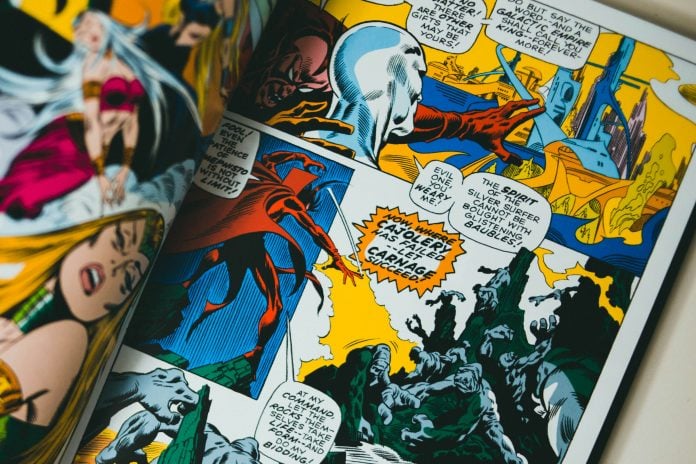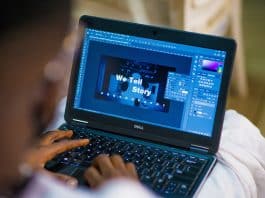Comic books are a unique subset of the publishing world. Sometimes it feels like it’s a whole different world with the special components and terminology. There are alot of different words to keep track of, and if you are new to the industry it can be daunting. In this article, you’ll find a list of comic book terms broken up into different categories to help make sense of it all. Familiarize yourself with these comic book terms to help you create the best comic possible.

Comic book creators
When it comes to comic book creation, there can be a whole team behind the process. Comic book creation does not always involve all of these different people, but larger scale projects likely have a big team. Here are all of the key terms related to those people and what they mean.
Writer
The writer is the brains behind the overall vision for the story. They write the dialogue, develop the characters and determine how the plot progresses.
Penciler
Once the script has been completed by the writer, the penciler draws the comic in pencil, which is eventually copied in ink and colored.
Inker
The inker is in charge of inking over the pencil drawings of the comic book art. This can be done both digitally or with actual ink. This person is also known as the finisher, as they add in more details to the artwork as well.
Colorist
The colorist adds the color to the comic after the inker goes over the pencil drawing. Again, this can be done both digitally or with colored ink. These days, most of these processes are done digitally.
Letterer
The letterer uses the script the writer put together to add all of the word balloons, thought bubbles and other sound effects to the comic.
Editor
As with any published writing, an editor is involved. An editor looks for any spelling issues, continuity within the story and errors in the art. They work closely with other storytellers to ensure that all elements and aspects of the comic make sense and don’t interfere with the plot of any other related comics.

Comic book formats
Comic books come in so many different formats, it can be hard to keep track of them all. The following is a breakdown of all of the different formats and what they mean.
Annual
An annual is an over-sized comic that is released in addition to the regular comics in a particular series.
Ashcan
The term ashcan refers to comics that are created as a prototype for an upcoming comic and are usually given away as promotional items
Collected Edition
This is when multiple single issues are collected to create an entire story or set of stories. Typically this consists of 5-6 single issues.
There are multiple types of collected editions which include:
- Trade paperback (TPB) – the most common type of collected edition is a trade paperback, often referred to as a “trade.” This comes in paperback format and typically includes 5-8 issues.
- Digest – digests are collected issues that are smaller in size.
- Hardcover (HC) – hardcovers are similar to trade paperbacks with the difference being that the cover is made of thick stock. Similar to a hardcover novel. This can often collect about 12 issues.
- Omnibus – an omnibus consists of very large collections of hardcovers and can collect 25 or more issues.
- Graphic Novel – any comic that is bound like a book is considered a graphic novel.
- Original Graphic Novel (OGN) – A comic that comes out in trade paperback or hardcover format without being published in the serial single issue format first.
Digital Comics
Comics that are published digitally and can be read on devices such as computers, tablets or mobile phones.
Digital First
A comic book that is released in digital format before it is printed.
Floppies
This is a slang term for the single issue of a comic.
Incentive Cover
A variant of the cover where the retailer must order a certain amount of a cover in order to be eligible to order the variant cover.
Limited Series/Mini-series
A comic series with a set number of issues. These most commonly come in six issues, but it can vary depending on the story. This series has a defined beginning, middle and end.
Maxi-series
A longer mini-series that typically consists of 12 issues or more. Each publisher has a different definition for a maxi-series.
Mini-comic
A comic that is smaller than the standard comic book size. These comics are often handmade and have small print runs.
One-shot
A story that is limited to a single issue.
Prestige Edition
Comics that are generally 48-64 pages in length and have a thin spine.
Single issue
This is the serial magazine-style format of a comic book. Single issues usually have 20-32 pages of story, though they can run longer.
Variant Cover
A variant cover is an alternative cover of a single issue comic. Fewer of these are available and they often feature art from a different artist.
Webcomic
Comics that are specifically made for reading on the internet.
Zine
A zine is a self-published and often handmade comic or magazine.

Other helpful comic book terms
The different elements of a comic book have their own terminology as well. Understanding these different components is key to creating a successful comic book of your own.
Panel
A panel refers to one of the boxes on a comic book page. Each box, aka panel, tells a piece of the story on the page and keeps the plot moving.
Gutter
This is the space between the panels. These spaces can be large or small and impact how easy it is to read the pages.
Word Balloon
A word balloon surrounds the dialogue that a specific character is saying. This usually has a directional arrow that points to the character that is speaking.
Caption
A caption is a box that is separate from the rest of the panel and is used to provide context for what’s happening through the voice of a narrator instead of a character.
Thought Bubble
A cloud-like enclosed shape that contains text and is used to visualize a character’s inner thoughts.
Sound Effect
A graphic element that is used to represent a sound, such as “POW!” or “BAM!”
Splash Page
A splash page is a single page that contains only one or a few large images. These are usually used for dramatic effect.
Whether you are creating a comic as an artistic project or exercise, or you are trying to publish your comic, understanding these key terms is crucial to your success. There are a lot of elements, and they can be hard to keep straight at times, but the more time you take to understand all of the elements, the easier the process will be.
Comic book printing
Ready to print your comic book? Printivity is here to help you bring your project to life. Contact one of our experts at 1-877-649-5463 with any questions or if you are ready to get your print going.




